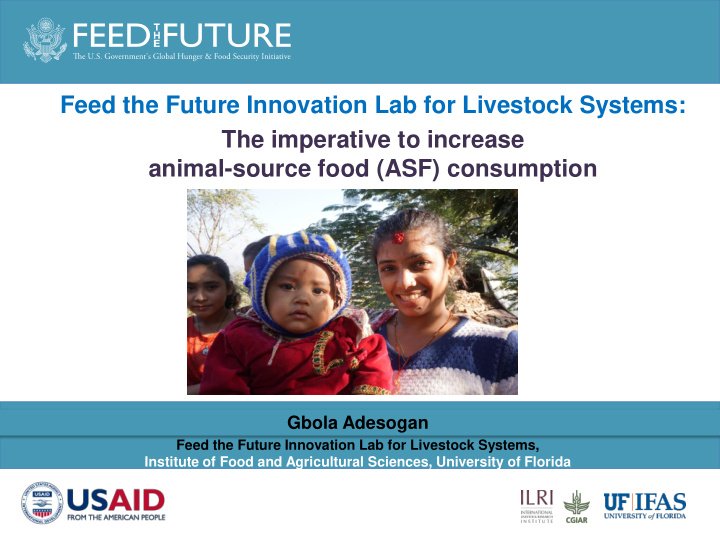



Feed the Future Innovation Lab for Livestock Systems: The imperative to increase animal-source food (ASF) consumption Gbola Adesogan Gbola Adesogan Feed the Future Innovation Lab for Livestock Systems, Institute of Food and Agricultural Sciences, University of Florida Photo Credit Goes Here
Global prevalence of stunting (malnutrition) Childhood malnutrition costs 20 to 30 $billion (Horton and Ross. Food Policy. 2003; 28: 51 – 57. R Martorell et al . J. Nutrition. 2010; 140: 348-54. (Adapted from Ianotti, 2014)
Important quotes • Stunting in the first 1000 days condemns children to a life time of underachievement and underperformance !!! - Roger Thurrow. Former Wall Street Journal Foreign Correspondent • Stunting in the first 1000 days is associated with nearly irreversible brain damage !!! - Senior nutritionist, World Food Program. • Some animal-source food consumption is needed for the growth and cognitive development in children and infants – Catherine Woteki, USDA Chief Scientist and Undersecretary for Agriculture
Protein quality of animal and plant-source foods Protein digestibility-corrected Biological value of protein amino acid scores 100 120 80 90 60 % 60 % 40 30 20 0 0 Meat Milk Eggs Rice Beans Corn Meat Milk Egg Rice Beans Corn (Michaelsen et al. 2009) http://www.food-info.net/uk/protein/bv.htm
Vitamin concentrations in animal and plant-source foods Vitamin B12 Vitamin A 180 1 150 0.8 μ g RAE per 100g μ g per 100g 120 0.6 90 0.4 60 0.2 30 0 0 Dror and Allen (2011) and Neumann et al. (2002) & USDA, ARS USDA, ARS
Vitamin B12 in breast milk of women relative to that representing adequate Intake (AI) (Allen, 2016) Recent Kenyan study (Williams et al. 2016) • 286 women 1-6 months postpartum • 89% had less breast milk B12 than recommended levels
Iodine concentrations of animal and plant-source foods 60 50 40 mcg/100gm 30 20 10 0 Meat Milk Eggs Rice Beans Corn Potatos Pennington et al. Young et al., 1995;
Zinc and iron concentrations of animal and plant source foods Iron Zinc 4 2.5 2 3 mg per 100g mg per 100g 1.5 2 1 1 0.5 0 0 Meat Milk Eggs Rice Beans Corn Potato Meat Milk Eggs Rice Beans Corn Potato USDA, ARS USDA, ARS Many plant foods have higher zinc and iron levels but they are bound to phytate and fiber and therefore less available
Quantity of different foods that meet a woman’s recommended daily iron intake (18 mg) (Gupta, 2012) Cooked beef Cooked beef, Cooked lentils/ Cooked kidney Cooked peas, Spinach, liver, 300g 625g chickpeas, 700g beans 810g 1.2 kg 2.4 kg (Dominguez-Salas and Bruyn)
Maternal prenatal iron intake (purple) correlates with fetal brain tissue organization Photo Credit: Bradley Peterson, MD, (Monk et al., 2015; sciencedaily.com)
Role of ASF in diets of Kenyan children buzzkenya.com/wp-content
ASF supplementation effects on children’s test scores Adapted from Demment, 2013; Weldon 2016
Meat group • Highest Raven scores • Higher Vit. B12 status • More physical activity • More Arm muscle mass • More leadership • Higher test scores • More playful Milk group • Improved growth • Higher test scores • Higher B12 status Adapted from Demment, 2013
Global meat consumption in 2005-7 vs. 2050
Feed the Future Innovation Lab for Livestock Systems Dr. Gbola Adesogan Photo Credit Goes Here
Vision To sustainably intensify animal-sourced food production in order to increase the incomes, livelihoods, nutrition and health of vulnerable people.
FOCAL COUNTRIES • West Africa – Burkina Faso and Niger • East Africa – Ethiopia, Rwanda & Uganda • South Asia – Nepal and Cambodia Photo credit: International Livestock Research Institute
Stunting Levels per Country 50 45 40 35 % OF POPULATION 30 25 20 15 10 5 0 http://www.who.int/nutgrowthdb/estimates2014/en/
Meat Consumption per Country 2013 140 120 KG/CAPITA/YEAR 100 80 60 40 20 0 FAO 2013, Current Worldwide Annual Meat Consumption per capita (excluding fish consumption), Food and Agriculture Organization of the United Nations, viewed 4/3/17, http://www.fao.org/faostat/en/#data/CL.
Milk Consumption Per Country 2013 300 250 KG/CAPITA/YEAR 200 150 100 50 0 Milk Consumption - Excluding Butter (Total) (kg/capita/yr), FAO Statistics Division 2013, http://www.fao.org/faostat/en/#data/CL, viewed 4/3/17.
Ethiopia Niger Rwanda Nepal Cambodia Niger Burkina Faso Livestock Systems Innovation Lab External Advisory Board meeting, March 8, 2016 Country Innovation Platform workshops Dr. Gbola Adesogan Photo Credit Goes Here
Feed the future initiative
Some LSIL-funded projects • Improving the quantity, quality and preservation of animal feeds (Nepal and Ethiopia) • Reducing mycotoxins in feeds and milk (Ethiopia and Rwanda) • Behavior change messaging to increase ASF consumption (Rwanda) • Creating evidence for enabling policies for ASF production (Ethiopia, Nepal) • Apps to improve marketing of ASF and disease surveillance (Nepal) • Increasing milk quality and safety (Nepal, Rwanda, Ethiopia) • Reducing diseases and mortality of young livestock (Ethiopia, Nepal, Rwanda) • Eradication of Peste de petits ruminant (Uganda)
Conclusions • Infant malnutrition can cause long term growth, developmental and neurological problems • Animal-source foods should be used to diversify the diets of infants and pregnant and lactating women in resource-poor countries • Concerted and coordinated efforts are needed to increase access to, affordability and availability of ASF • LSIL is working at sustainably intensifying ASF production and consumption to improve the nutrition and incomes of the poor
www.feedthefuture.gov
Recommend
More recommend